The most powerful magnets in the Universe: Magnetars
An object so magnetic it can strip information from all credit cards on Earth at half the Moon distance.
50,000 light years away on the other side of the Milky Way galaxy, lies a stellar monster. An object so dense it packs about the mass of the Sun in the size of a city. An object consisting almost entirely of neutrons. An object so magnetic it can strip information from all credit cards on Earth at half the Moon distance. Welcome a magnetar.
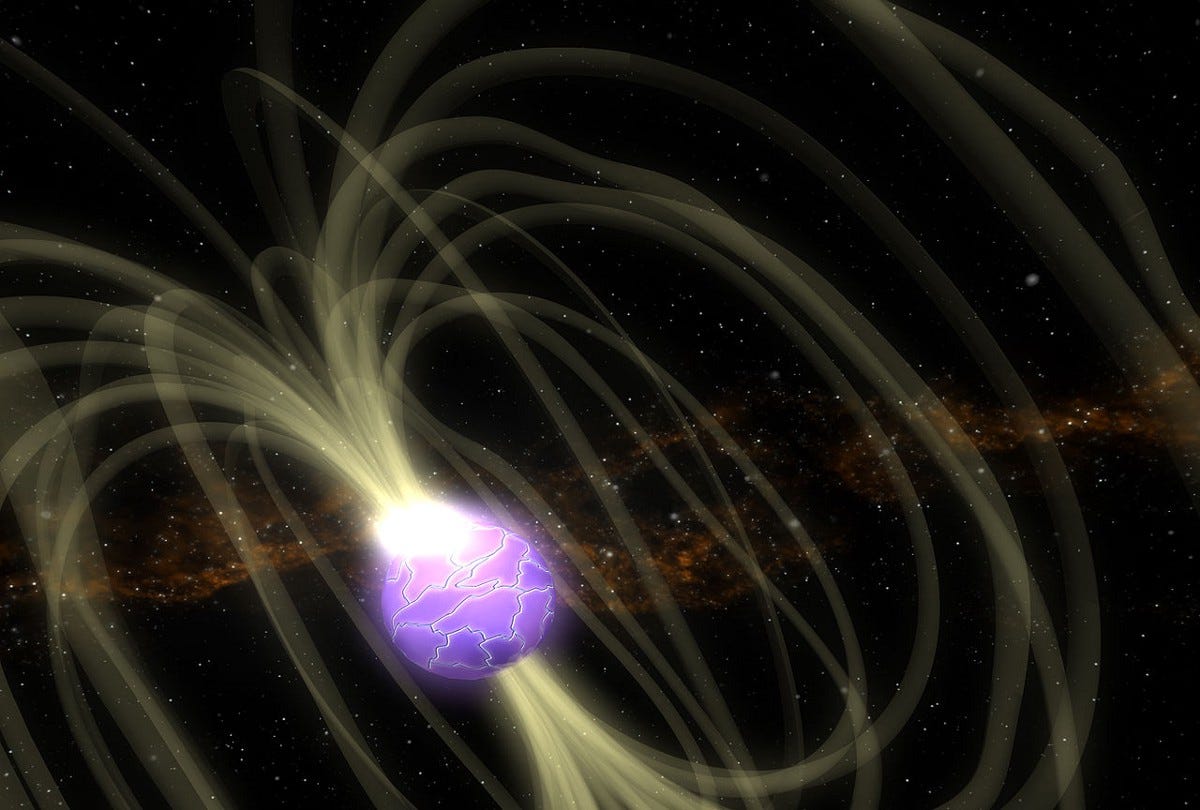
Just how powerful is the magnetic field of a magnetar?
A magnetar (a type of neutron star) has a magnetic field as strong as 10¹⁴-10¹⁵ Gauss, making it the most magnetic object (known) in the Universe. To put things into perspective, here is a comparison of its field strength to other magnetic objects:
- Earth’s magnetic field (which deflects compass needles) = 0.6 Gauss
- A common commercial magnet = ~100 Gauss
- Sunspots (the most magnetic parts of the Sun) = ~3,000 Gauss
- MRI machines = Up to 70,000 Gauss
- The strongest steady magnetic field produced in labs = 450,000 Gauss
- Highly magnetized white dwarf stars = Up to 1 billion Gauss
- Typical neutron stars = ~1 trillion Gauss
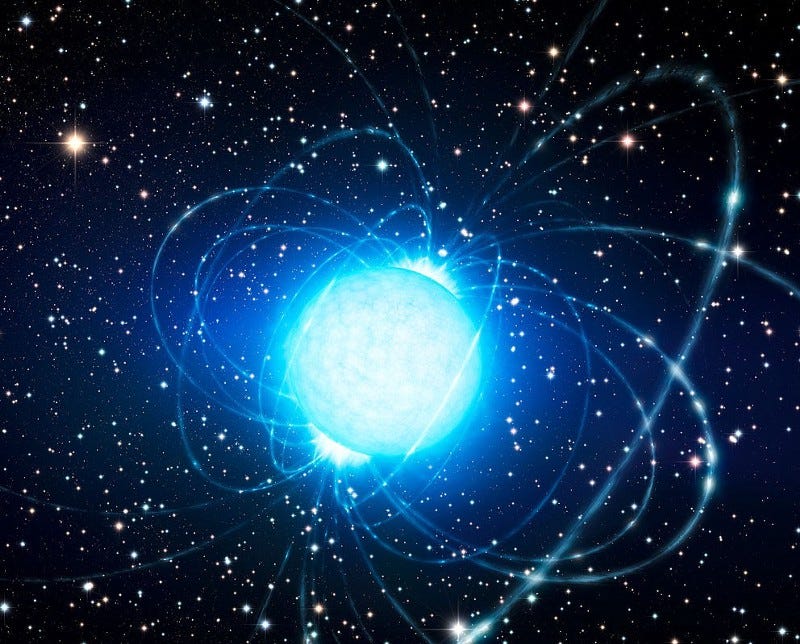
To sum it up, a magnetar has a magnetic field ~100–1000 times more powerful than a neutron star, a billion times more than what we can produce in lab and trillions of times more than sunspots. Let it sink.
What are the effects of a magnetar’s powerful magnetic field?
#1: Atoms are compressed into thin needles
A strong magnetic field squeezes the atoms in the direction of the field, like this:
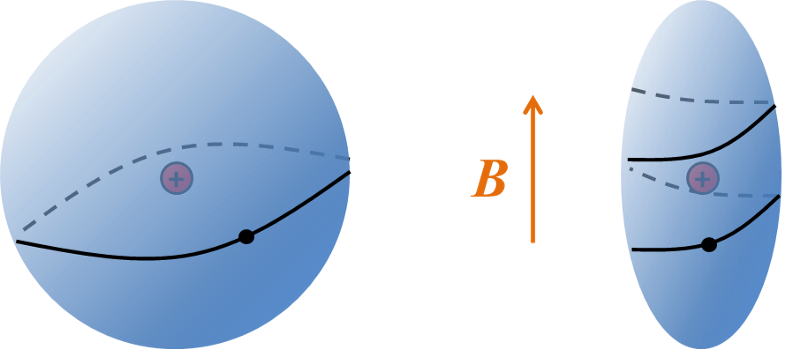
While most of a neutron star consists of purely neutrons (duh!), the surface still has atoms, being at a much lesser pressure than the interior. In a magnetic field as strong as that of a magnetar, these atoms would be squeezed to the point where they would be long & needle shaped. Such atoms can form long polymer-like chains, covering the surface of the magnetar.
Even from thousands of kilometers away, such a strong magnetic field would distort and rip apart all the molecular bonds of your body (you die).
#2: Vacuum is polarized and behaves like a prism, light can split and merge
The empty space around a neutron star doesn’t let all of the vibrations of light to pass through as one would expect. According to quantum electrodynamics (QED), a highly magnetized vacuum behaves like a prism and polarizes light, similar to how sunglasses would polarize light.
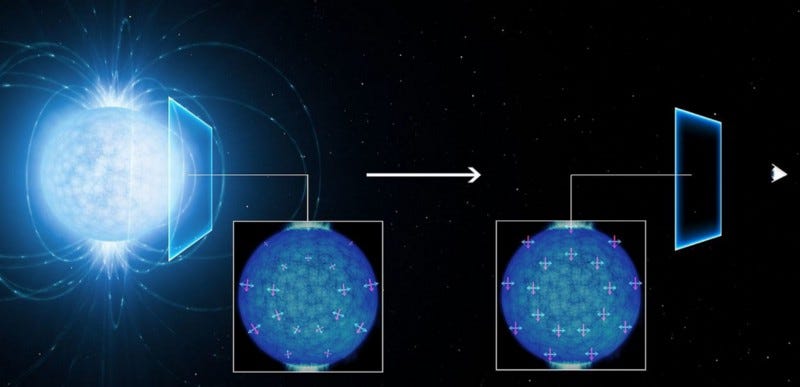
Such vacuum polarization of light means that only certain magnetic and electric field directions of light are let through, as was confirmed for the first time in 2016 for a neutron star.
For an even higher magnetic field like that of a magnetar, there is a surge of virtual electron-positron pairs in the vacuum. Such a high vacuum birefringence split X-ray photons into two or two photons merge together.
How do magnetars acquire such high magnetic fields?
Neutrons stars form under extreme conditions. During the supernova core collapse, the core is crushed by gravity so much that temperature and density skyrockets. Since the core is crushed to a mere city size while keeping about the same mass, the rotation rate is extremely high (due to conservation of angular momentum like in the case of a ballet dancer). Neutron stars are known to rotate around themselves from within a few milliseconds to a few seconds.
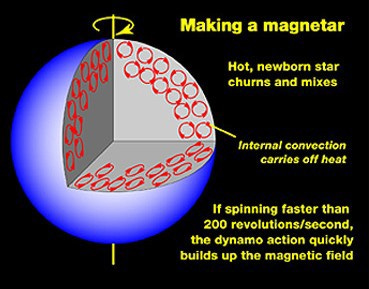
The hot, dense neutron fluid in the core churns & mixes rapidly due to convection and the star’s rotation. Given the right rotation rate, temperature and magnetic field, a dynamo mechanism like for the Earth’s or Sun’s magnetic fields can increase the neutron star’s magnetic field to magnetar levels.
Magnetars produce the most intense blasts in the Universe
The crust of a magnetar is twisted and turned by the immense magnetic field at the core. This heats the interior and the resulting stress leads to starquakes, akin to earthquakes. The magnetic field is shaken causing a violent burst of energy in the form of gamma rays, as the field tries to rearrange itself to a stable state.
December 27, 2004 saw the onslaught of one such spectacular blast from the magnetar SGR 1806–20. The excessive burst of gamma rays coming from it partially ionized the Earth’s upper atmosphere, from halfway across the galaxy! The burst of energy was so intense that it saturated NASA’s Swift telescope detectors, a spacecraft designed to observe gamma-ray bursts.

In a mere 1/5th of a second, the magnetar gave off as much energy as our Sun would in 250,000 years! If the magnetar had been within a 1,000 light years, it could have easily triggered a mass-extinction event on Earth. This makes it more intense than even a supernova, which is considered safe at ~100 light years. Magnetars are fascinating. And scary.
More for the curious: http://solomon.as.utexas.edu/magnetar.html
